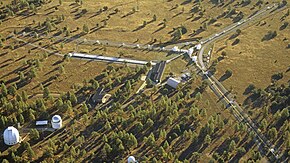 Navy Precision Optical Precision Interferometer at the Anderson Mesa Station of Lowell Observatory. | |
| Alternative names | NPOI |
|---|---|
| Part of | United States Naval Observatory Flagstaff Station |
| Location(s) | Arizona |
| Coordinates | 35°05′45″N 111°32′02″W / 35.0959°N 111.534°W |
| Organization | Lowell Observatory United States Naval Observatory Flagstaff Station United States Naval Observatory United States Naval Research Laboratory |
| Altitude | 2,163 m (7,096 ft) |
| Built | 1992–1994 |
| First light | 1994 |
| Telescope style | astronomical interferometer Michelson interferometer |
| Website | lowell |
| | |
The Navy Precision Optical Interferometer (NPOI) is an American astronomical interferometer, with the world's largest baselines, operated by the Naval Observatory Flagstaff Station (NOFS) in collaboration with the Naval Research Laboratory (NRL) and Lowell Observatory. The NPOI primarily produces space imagery and astrometry, the latter a major component required for the safe position and navigation of all manner of vehicles for the DoD. The facility is located at Lowell's Anderson Mesa Station on Anderson Mesa about 25 kilometers (16 mi) southeast of Flagstaff, Arizona (US). Until November 2011, the facility was known as the Navy Prototype Optical Interferometer (NPOI). Subsequently, the instrument was temporarily renamed the Navy Optical Interferometer, and now permanently, the Kenneth J. Johnston Navy Precision Optical Interferometer (NPOI) – reflecting both the operational maturity of the facility, and paying tribute to its principal driver and retired founder, Kenneth J. Johnston.[1][2]
The NPOI project was initiated by the United States Naval Observatory (USNO) in 1987.[3] Lowell joined the project the following year when the USNO decided to build the NPOI at Anderson Mesa.[4] The first phase of construction was completed in 1994, which allowed the interferometer to see its first fringes, or light combined from multiple sources, that year.[5] The Navy began regular science operations in 1997.[6] The NPOI has been continuously upgraded and expanded since then, and has been operational for a decade. The workings of NPOI as a classic interferometer, are described at Scholarpedia,[7] and at the NPOI site.[8]
- ^ Cite error: The named reference
NOI-ANNCwas invoked but never defined (see the help page). - ^ "Archived copy". Archived from the original on 2013-10-04. Retrieved 2013-01-25.
{{cite web}}: CS1 maint: archived copy as title (link) - ^ Cite error: The named reference
1998WHITwas invoked but never defined (see the help page). - ^ Cite error: The named reference
1997HUTTwas invoked but never defined (see the help page). - ^ Cite error: The named reference
1995HUTTwas invoked but never defined (see the help page). - ^ Cite error: The named reference
1997ARMwas invoked but never defined (see the help page). - ^ Hutter, Donald (2012). "Ground-based optical interferometry". Scholarpedia. 7 (6): 10586. Bibcode:2012SchpJ...710586H. doi:10.4249/scholarpedia.10586.
- ^ "NPOI - Navy Prototype Optical Interferometer". Archived from the original on 2010-05-27.
